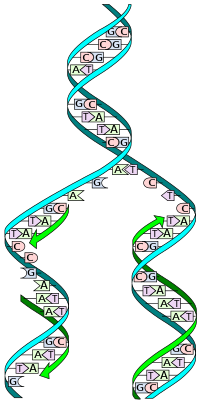
Photo from wikipedia
Centrin is a member of the EF-hand super family of calcium-binding proteins, which can behave as a part of damage detector initiated the initiation of nucleotide excision repair (NER). Its… Click to show full abstract
Centrin is a member of the EF-hand super family of calcium-binding proteins, which can behave as a part of damage detector initiated the initiation of nucleotide excision repair (NER). Its self-assembly plays a causative role in fiber contraction associated with the cell division cycle and ciliogenesis. To explore the possible role of DNA in the process of centrin self-assembly, the aggregation properties of N-terminal domain of Euplotes octocarinatus centrin (N-EoCen) in the presence of DNA with or without metal ions are investigated. It is verified that metal ions, such as Ca2+ and Tb3+, can bind to N-EoCen with 2:1 stoichiometry by isothermal titration calorimetry (ITC). Importantly, this study reports that double strand DNA (dsDNA) is capable of binding N-EoCen, changing conformation of protein and modulating centrin aggregation, as demonstrated by extensive biophysical assays. Interestingly, the open conformation of protein induced by metal ions may be favour of the interaction of protein with dsDNA. Nevertheless, the randomly coiled single strand DNA (ssDNA) is completely inefficient to the aggregation regulation. Furthermore, results reveal that hydrophobic site could play important role in the process. This finding may link to the potent roles of centrin in the NER process.
Journal Title: Journal of inorganic biochemistry
Year Published: 2018
Link to full text (if available)
Share on Social Media: Sign Up to like & get
recommendations!